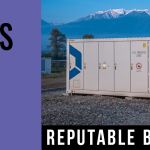 There’s currently a lot of talk about how we support environmental legislation while balancing a grid under pressure, not to mention how to meet future energy demands. In answering those questions, there are many different solutions being discussed and explored.
There’s currently a lot of talk about how we support environmental legislation while balancing a grid under pressure, not to mention how to meet future energy demands. In answering those questions, there are many different solutions being discussed and explored.
In areas such as North and South America specifically, frequent severe weather incidents that bring down grid power for weeks and months, such as last year’s Hurricane Irma and the more immediate Hurricane Florence, require much more direct and immediate solutions.
And this is where the use of a decentralized grid or microgrids are now not only being trialled for critical backup power, but for some more remote communities, used as mainstream primary power too. For the modern utility business, these solutions are very different, but increasingly viewed as very compelling business models – and for me, they’re really exciting too.
The compromise for many, though, has been the continued reliance on polluting and un-environmental diesel generator technology to support these projects. However, there’s now a 100 percent clean, weather independent solution that’s not only ready to replace diesel generators, but also provide a host of other benefits too – the modern fuel cell.
What is a microgrid?
If you’re unfamiliar with the microgrid concept, according to the US Department of Energy: “A microgrid is a local energy grid with control capability, which means it can disconnect from the traditional grid and operate autonomously. A microgrid can be powered by distributed generators, batteries, and/or renewable resources like solar panels. Depending on how it’s fuelled and how its requirements are managed, a microgrid might run indefinitely.”
Essentially, a microgrid can backup the grid, or crucially, operate independently. This makes them hugely attractive to local communities wishing to take control of their power generation, as well as rural communities looking for robust and independent electricity supply.
In the continued global shift to renewable energy generation to counter climate change, microgrids enable communities large and small to improve local energy delivery by leveraging the best of green technologies.
Very often, various renewable technologies such as wind turbines and solar panels can be placed within residential buildings, alongside a battery to provide an alternative power source to the grid – not only providing environmental benefits, but also increasing energy efficiency and cost-savings. However, the performance of renewables is subject to variable weather conditions, which frustrates their ability to provide 100 per cent reliability.
read more
 Energy storage is a compelling complement to wind and solar, because of high flexibility and ability to operate as both load, when it charges, and generation, when the energy is deployed. Energy storage addresses many of the challenges to grid operators providing safe and reliable electricity for customers, and due to rapidly declining costs, performance improvements of lithium-ion batteries and an emergence of “grid-ready” energy storage products, commercially viable grid energy storage has now arrived, in certain applications. As energy storage becomes more widely available and economically feasible, it may make renewable generation, when paired with energy storage, a more viable option to provide reliable electric generation – and load demand – service in more areas of the world.
Energy storage is a compelling complement to wind and solar, because of high flexibility and ability to operate as both load, when it charges, and generation, when the energy is deployed. Energy storage addresses many of the challenges to grid operators providing safe and reliable electricity for customers, and due to rapidly declining costs, performance improvements of lithium-ion batteries and an emergence of “grid-ready” energy storage products, commercially viable grid energy storage has now arrived, in certain applications. As energy storage becomes more widely available and economically feasible, it may make renewable generation, when paired with energy storage, a more viable option to provide reliable electric generation – and load demand – service in more areas of the world. National Grid has begun operating a vanadium redox-flow battery (VRB) with its 1-MW solar PV array in Shirley, Mass., to demonstrate utility operation of storage.
National Grid has begun operating a vanadium redox-flow battery (VRB) with its 1-MW solar PV array in Shirley, Mass., to demonstrate utility operation of storage. Power grid infrastructure in many parts of the United States is aging and struggling to meet increased electricity demand. In some specific areas, like ports and industrial facilities, high-powered equipment cannot be fully deployed because the grid cannot meet the intense but sporadic load demands.
Power grid infrastructure in many parts of the United States is aging and struggling to meet increased electricity demand. In some specific areas, like ports and industrial facilities, high-powered equipment cannot be fully deployed because the grid cannot meet the intense but sporadic load demands. The US Department of Energy is launching a major research effort to develop a new generation of lithium-ion batteries largely free of cobalt, a rare and expensive metal delivered through an increasingly troubling supply chain.
The US Department of Energy is launching a major research effort to develop a new generation of lithium-ion batteries largely free of cobalt, a rare and expensive metal delivered through an increasingly troubling supply chain. Energy Storage North America (ESNA), the most influential gathering of policy, technology and market leaders in energy storage, applauds Governor Jerry Brown and the California State Legislature for passing landmark Senate Bill (SB) 100, which sets the largest-scale zero-emission electricity targets ever established for a U.S. state.
Energy Storage North America (ESNA), the most influential gathering of policy, technology and market leaders in energy storage, applauds Governor Jerry Brown and the California State Legislature for passing landmark Senate Bill (SB) 100, which sets the largest-scale zero-emission electricity targets ever established for a U.S. state. Several of the proposals approved by CAISO’s board on Wednesday were part of the third and final phase of the Energy Storage and Distributed Energy Resources (ESDER) initiative that stakeholders launched to foster greater participation of those resources in the wholesale market.
Several of the proposals approved by CAISO’s board on Wednesday were part of the third and final phase of the Energy Storage and Distributed Energy Resources (ESDER) initiative that stakeholders launched to foster greater participation of those resources in the wholesale market. The California legislature has put its stamp of approval on SB 700, a bill that will provide up to $830 million in new incentives to add behind the meter storage to residential and small business solar systems. “What we’re trying to do is create a mainstream market for energy storage, like we’ve done for solar PV,” Bernadette Del Chiaro, executive director of the California Solar & Storage Association, tells Green Tech Media.
The California legislature has put its stamp of approval on SB 700, a bill that will provide up to $830 million in new incentives to add behind the meter storage to residential and small business solar systems. “What we’re trying to do is create a mainstream market for energy storage, like we’ve done for solar PV,” Bernadette Del Chiaro, executive director of the California Solar & Storage Association, tells Green Tech Media.



